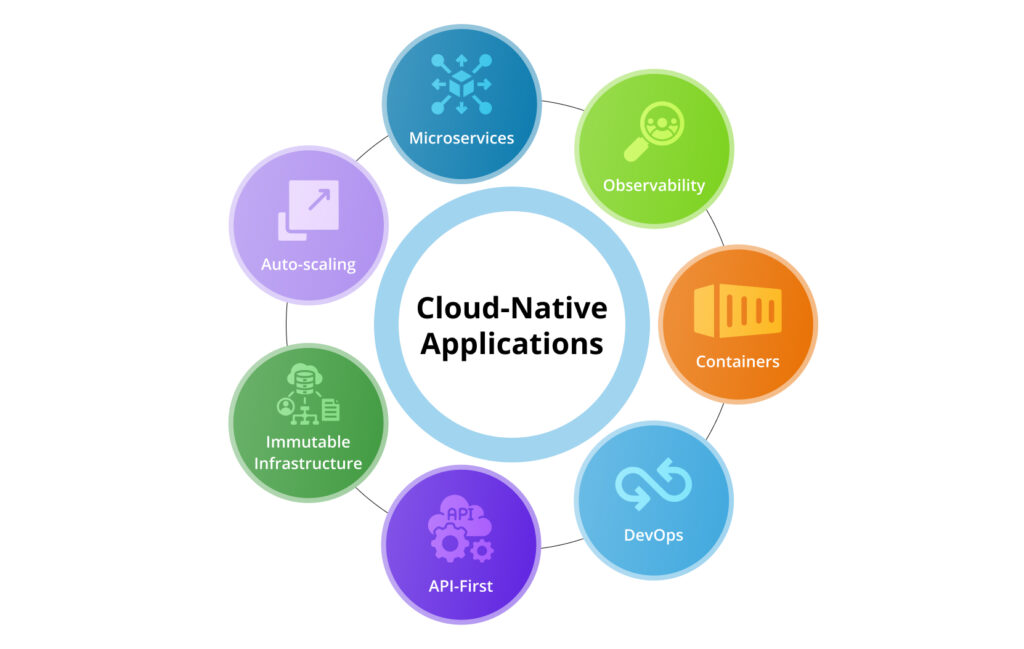Businesses want their applications to be high-performing, resilient, and easily scalable to meet changing market needs. Cloud environment is perfect for developing and placing applications that meet the above requirements. They are fully optimised to run in the cloud, which is why they are also called cloud native, and harness all the benefits of a cloud environment.
- Cloud native applications = the ones “born” in the cloud
- Cloud Native Benefits and Disadvantages
- The Difference between Cloud-Based and Cloud Native Applications
Cloud native applications = the ones “born” in the cloud
First, let’s remember what a cloud environment is, but for that, we have to roll back to physical resources (servers, storage, data transmission networks) and virtualisation systems. Combined, they are called cloud infrastructure, making it possible to deliver the resources already virtualised to end-users over the Internet. The configuration of cloud infrastructure is determined by cloud architecture, which is the outline for arranging the cloud computing environment. In other words, cloud infrastructure is a set of hardware and software components that form the cloud computing environment used to deliver services and virtual resources over the Internet.
It is in the cloud environment that cloud native applications are created. Developers design them from scratch, test them, place them, and ultimately deliver them to end users right in the cloud. Moreover, cloud services and technologies are used to optimise these processes and reduce the time it takes to work on an application.
Here are the fundamentals of building cloud native applications:

Cloud Native Benefits and Disadvantages
Cloud native applications are designed very differently from traditional ones, and the cloud environment has largely made this possible. The main difference from traditional development is that cloud native applications are broken down into small services (microservices). Microservice architecture applications are superior to traditional monolithic applications (which can also be placed in the cloud) based on the following criteria:
- short application lifecycle;
- high fault tolerance;
- flexible scaling;
- good manageability.
Since particular microservices are placed on different servers, cloud native applications can be easily scaled horizontally. Furthermore, they are initially designed with redundant capacity, so they are more fault-tolerant and can more easily withstand hardware and software failures.
At the same time, there are certain cloud native challenges when dealing with cloud native applications. The main challenge is data confidentiality and security, which needs to be managed on both sides: by the service provider and directly by the app owner. Other challenges include connection to a specific provider, ensuring high network bandwidth to maximise performance, managing costs and cloud resources in general, and requiring specialised skills and expertise.
The Difference between Cloud-Based and Cloud Native Applications
Cloud applications is a generic concept used for all software solutions placed in the cloud. It includes two types of applications:
Cloud-based applications are applications based on cloud technologies. Such applications have been migrated to the cloud at some point in their lifecycle, although they were originally developed for traditional IT infrastructure. In such cases, before migration to the cloud, modifications are made to the internal structure of the application, and the cloud itself requires integration with cloud services, databases, advanced analytical and other tools.
Cloud native applications are applications that were originally developed in the cloud and for the cloud, utilising cloud technologies and cloud computing advantages. Such software solutions do not require extra customisation for the dynamic cloud environment.
Colobridge’s Expert:
“We offer a large portfolio of cloud native solutions, including any cloud model and computing resource configurations to ensure that our customers have complete freedom of choice when developing cloud applications and placing them in the corporate cloud. Furthermore, our team is always ready to assist with migrating applications from traditional IT infrastructure to the cloud. We will also make sure that the client’s business continuity is maintained – we will plan and migrate data at a time when the infrastructure is least loaded.”
To find out more about the options for placing or migrating applications to the cloud, contact the managers at German corporate provider Colobridge.





